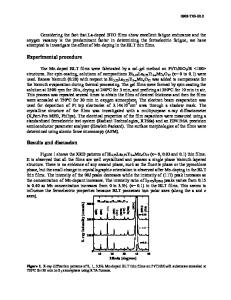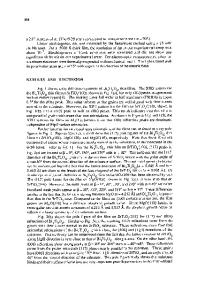Ferroelectric memory in La substituted Bi 4 Ti 3 O 12 thin films
- PDF / 166,010 Bytes
- 6 Pages / 612 x 792 pts (letter) Page_size
- 68 Downloads / 385 Views
C11.11.1
Ferroelectric memory in La substituted Bi4Ti3O12 thin films R.E. Melgarejo and M.S. Tomar Physics Department, University of Puerto Rico, Mayagüez, PR 00681-9016, ABSTRACT The recent demonstration of large ferroelectric memory in rare earth substituted Bi4Ti3O12 attracted a lot of research interest in this material. Bi4-xLaxTi3O12 was synthesized by sol-gel route for different compositions: x = 0.00, 0.46, 0.56, 0.75, 0.95 and thin films were deposited by spin coating on Pt (Pt/TiO2/SiO2/Si) substrate. The post annealed films at 700oC were studied for their structural studies using x-ray diffraction and Raman spectroscopy. The prominent effect of La substitution is observed in low frequency Raman modes. X-ray diffraction and Raman studies show that the film growth was c-axis suppressed. Using improved contacts to Pt substrate, ferroelectric polarization Pr = 51 µC/cm2 has been achieved for 0.63 µm thick film of composition: x = 0.56 (BLT56) without appreciable fatigue.
INTRODUCTION Bismuth titanate (Bi4Ti3O12) is within Aurivillius phase materials (An-1BnO3n+1) that have a monoclinic ferroelectric structure [1-3] with one component of the polarization in the plane of the layers and the other perpendicular to this plane. This material consists of Bi2O2 layers and perovskite-type structures with triple TiO6 octahedra and A-site Bi atom. The Bi3+ ion in A-site is strongly under bonded and Ti4+ ion in B-site is slightly over bonded. As a result, both the Bi2O2 layer and TiO6 tetrahedron are considerably distorted. Therefore, the origin of ferroelectric polarization within the layers may be due [3] to large displacement of Bi3+ cations in the perovskite A-site with respect to the chain of TiO6 octahedra. If Bi ions are partially substituted by suitable trivalent ions in Bi4Ti3O12 near the Ti-O octahedra layers, ferroelectric behavior could be altered [4]. Therefore, rare earth substituted Bi4Ti3O12 thin films are of considerable research interest for ferroelectric and microwave applications. Bi3.25La0.75Ti3O12 (BLT75) films deposited by metal organic vapor phase epitaxy [5] (MOVPE) and chemical solution deposition [6] (CSD) showed weak ferroelectric polarization. However, La substituted Bi4Ti3O12 films deposited by pulsed laser deposition
C11.11.2
(PLD) showed remnant polarization [7] Pr = 32 µC/cm2.
We recently studied [8] the
structural, dielectric, and ferroelectric properties of sol-gel derived Bi3.44La0.56Ti3O12 (BLT56) thin films. The ferroelectric polarization Pr = 40 µC/cm2 was reported [8]. The objective of the present work was to study the La substituted Bi4Ti3O12 thin films for various La content and study the effect on its structural and ferroelectric polarization.
EXPERIMENTAL AND RESULTS Bismuth nitrate, lanthanum acetate, and titanium isopropoxide were used as the precursors for Bi, La, and Ti, respectively in acetic acid and methoxy-ethanol solvents. Bi content in access of 5 atomic weight percent were utilized during sol-gel processing, and thin films with compositions x = 0.00, 0.46, 0.5
Data Loading...











